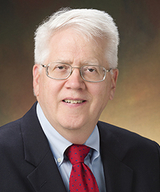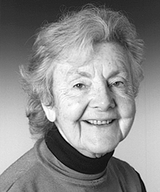Fall 2022 saw the loss of two more CHOP luminaries as Ralph Wetmore, MD, former Chief of Otolaryngology, and Audrey Evans, MD, former Chief of Oncology, died in September.

Dr Wetmore joined CHOP in 1981, and, along with Drs William Potsic and Steve Handler, played a critical role in the expansion of the division. He became the division’s second Chief in 2008 and led the recruitment of 7 of the current 17 pediatric otolaryngology faculty. He oversaw the expansion of ENT’s Advanced Practice Nurses team, the launch of the Balance and Vestibular Program and the naming of the Center for Pediatric Airway Disorders as a Frontier Program.
Dr Wetmore held the E. Mortimer Newlin Endowed Chair in Pediatric Otolaryngology and Human Communication and served on the Executive Committee of the Medical Staff and on many leadership roles within Children’s Surgical Associates. On a national level, Dr Wetmore served as the President of the Society for Ear, Nose and Throat Advances in Children and the President of the American Society of Pediatric Otolaryngology.

Dr Evans was recognized nationwide for co-leading the effort to create what became the first Ronald McDonald House in 1974. But before she teamed with Jim Murray, then general manager of the Philadelphia Eagles, to open the first facilities for families to stay close to their hospitalized children, she was already a world-renowned pediatric oncologist.
She was recruited to CHOP by in 1969 by future Surgeon General C. Everett Koop to be the first Director and Chief of the Division of Oncology. She served as chair until 1989, and was appointed a professor of pediatrics at the University of Pennsylvanian School of Medicine in 1972. She developed what was later called the Evans Staging System, a methodology for assessing neuroblastoma patients.
She created and led Advances in Neuroblastoma Research conference, now a leading biennial international symposium for physicians and researchers who focus on neuroblastoma. Dr Evans was key to the formation of the first childhood cancer cooperative groups and led many of the early seminal studies. These efforts led to a dramatic rise in cure rates in a variety of childhood cancers, as well as establishing the infrastructure for advancements made since.
The National Institutes of Health lists her as being honored with the Janeway Award of the American Radium Society, the American Society of Pediatric Hematology/Oncology Distinguished Career Award, an award from the American Cancer Society, the Spectrum Award of the American Red Cross, the Alpha Delta Kappa International Woman of the Year Award, and the Osler Award, one of the UPenn’s most prestigious awards.
Her lifelong commitment to childhood cancer and her dedication to not only improving outcomes, but also to do so with a focus on quality of life during and after treatment, made her a trailblazer. Her holistic view of how serious illness impacts not just the patient, but the entire family, became the foundation for the creation of the original Ronald McDonald House in Philadelphia, which has served as the model for the now 375 Homes around the world today.
A Hub of Activity at the Hub
The Hub for Clinical Collaboration, a 17-story, 550,000-square-foot building tucked between the Buerger Center for Advanced Pediatric Care and Health Sciences Drive, opened fully this fall. In addition to offices and meeting spaces for physicians and staff formerly located in the Wood Building, it also features a professionals’ lounge, an employee fitness center, and conference space that includes a 264-seat auditorium.
Outpatient Psychiatry Has a New Home

Outpatient services for the Department of Child and Adolescent Psychiatry and Behavioral Sciences has moved to a newly renovated, larger building at 4601 Market St. The new Center for Advanced Behavioral Healthcare, located on the third floor of the former Provident Mutual Life Insurance Co. building, has 64 office/consultation rooms, 5 group therapy rooms, and 5 calming rooms in 47,000 square feet of space. The space was created with the needs of children and youth in mind, with soothing, comfortable furniture, and several waiting areas, including one with interactive activities and a quiet study area.
Fall 2022 saw the loss of two more CHOP luminaries as Ralph Wetmore, MD, former Chief of Otolaryngology, and Audrey Evans, MD, former Chief of Oncology, died in September.

Dr Wetmore joined CHOP in 1981, and, along with Drs William Potsic and Steve Handler, played a critical role in the expansion of the division. He became the division’s second Chief in 2008 and led the recruitment of 7 of the current 17 pediatric otolaryngology faculty. He oversaw the expansion of ENT’s Advanced Practice Nurses team, the launch of the Balance and Vestibular Program and the naming of the Center for Pediatric Airway Disorders as a Frontier Program.
Dr Wetmore held the E. Mortimer Newlin Endowed Chair in Pediatric Otolaryngology and Human Communication and served on the Executive Committee of the Medical Staff and on many leadership roles within Children’s Surgical Associates. On a national level, Dr Wetmore served as the President of the Society for Ear, Nose and Throat Advances in Children and the President of the American Society of Pediatric Otolaryngology.

Dr Evans was recognized nationwide for co-leading the effort to create what became the first Ronald McDonald House in 1974. But before she teamed with Jim Murray, then general manager of the Philadelphia Eagles, to open the first facilities for families to stay close to their hospitalized children, she was already a world-renowned pediatric oncologist.
She was recruited to CHOP by in 1969 by future Surgeon General C. Everett Koop to be the first Director and Chief of the Division of Oncology. She served as chair until 1989, and was appointed a professor of pediatrics at the University of Pennsylvanian School of Medicine in 1972. She developed what was later called the Evans Staging System, a methodology for assessing neuroblastoma patients.
She created and led Advances in Neuroblastoma Research conference, now a leading biennial international symposium for physicians and researchers who focus on neuroblastoma. Dr Evans was key to the formation of the first childhood cancer cooperative groups and led many of the early seminal studies. These efforts led to a dramatic rise in cure rates in a variety of childhood cancers, as well as establishing the infrastructure for advancements made since.
The National Institutes of Health lists her as being honored with the Janeway Award of the American Radium Society, the American Society of Pediatric Hematology/Oncology Distinguished Career Award, an award from the American Cancer Society, the Spectrum Award of the American Red Cross, the Alpha Delta Kappa International Woman of the Year Award, and the Osler Award, one of the UPenn’s most prestigious awards.
Her lifelong commitment to childhood cancer and her dedication to not only improving outcomes, but also to do so with a focus on quality of life during and after treatment, made her a trailblazer. Her holistic view of how serious illness impacts not just the patient, but the entire family, became the foundation for the creation of the original Ronald McDonald House in Philadelphia, which has served as the model for the now 375 Homes around the world today.
A Hub of Activity at the Hub
The Hub for Clinical Collaboration, a 17-story, 550,000-square-foot building tucked between the Buerger Center for Advanced Pediatric Care and Health Sciences Drive, opened fully this fall. In addition to offices and meeting spaces for physicians and staff formerly located in the Wood Building, it also features a professionals’ lounge, an employee fitness center, and conference space that includes a 264-seat auditorium.
Outpatient Psychiatry Has a New Home

Outpatient services for the Department of Child and Adolescent Psychiatry and Behavioral Sciences has moved to a newly renovated, larger building at 4601 Market St. The new Center for Advanced Behavioral Healthcare, located on the third floor of the former Provident Mutual Life Insurance Co. building, has 64 office/consultation rooms, 5 group therapy rooms, and 5 calming rooms in 47,000 square feet of space. The space was created with the needs of children and youth in mind, with soothing, comfortable furniture, and several waiting areas, including one with interactive activities and a quiet study area.